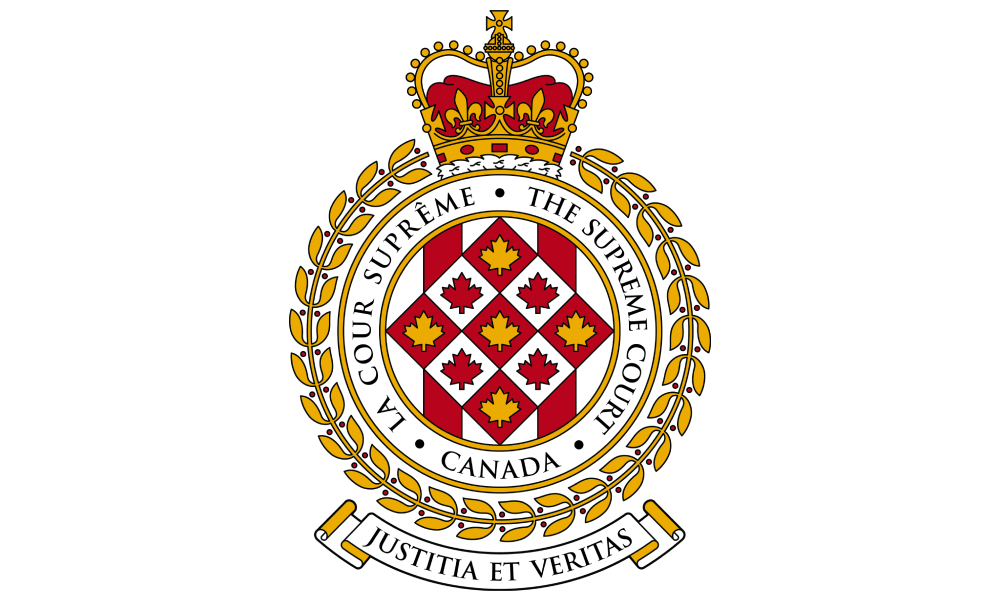
New heraldic emblems tell the story of court’s ‘past, present and future with poise and elegance’

On Monday, the Supreme Court of Canada unveiled its new coat of arms, flag and badge, granted by Canada’s chief herald as an honour from the Canadian Crown, and announced its new motto.
“Designed by the former Chief Herald of Canada, Ms. Claire Boudreau, these emblems express the values of our institution: that is, justice, independence, integrity, transparency, and bilingualism,” Chief Justice of Canada Richard Wagner said in remarks during the small unveiling ceremony at the Supreme Court.
“Until now, the court has used same emblems as the Canadian state’s executive and legislative powers: that is, the Canadian coat of arms,” he said. “In recent years, we have unofficially adopted the emblem engraved in the marble columns of our grand entrance hall, designed by [Montreal architect] Ernest Cormier.”
Every detail of the new emblem was given careful consideration, including the new motto: “Justitia et Veritas,” or Justice and Truth. These are also the names of the two allegorical statues standing outside the Supreme Court building in Ottawa.
“This court hopes that with these important symbols, every Canadian may find an element that speaks to them,” said Chief Justice Wagner.
Chief Herald of Canada Samy Khalid presented the new emblems.
“It is with great pride that I present to the highest court in Canada its own badges and flag,” Khalid said, also noting that the Supreme Court had “helped us shape our country” for over 145 years.
“These new heraldic emblems express the identity of the Supreme Court: they tell the story of its past, present and future with poise and elegance.”
The court described the heraldic emblems, designed by previous Chief Herald Boudreau (who died in November) in a news release as “rich with symbolism. The round shape at the center represents harmony and collegiality, while the white background conveys the ideals of transparency and accessibility. Two vertical red stripes represent parallel paths, such as the Court’s bilingual and bijural traditions. The stripes also recall the principles of peace and mutual respect of the two-row wampum belt.”
The Coat of Arms includes the laurels from the court’s historic badge, created by Cormier, who designed the Supreme Court building. The Cormier emblem is embedded in the Grand Hall’s marble floor and features the stylized letters S and C, surrounded by laurels.
Chief Justice Wagner petitioned the Office of the Chief Herald for heraldic emblems for the Supreme Court in early 2019, the court’s senior strategic communication advisor told Canadian Lawyer in an email.
“Going forward, the Court will use the new insignia/coat of arms on judicial documents such as judgments, orders and bulletins of proceeding,” said Alison Crawford. “The badge, which is a new interpretation of the Cormier emblem embedded in marble in the Grand Hall, will continue to be used on the sign outside and administrative documents,” and the flag will fly whenever the court is in session.
With the new coat of arms, badge and flag, the Supreme Court visually communicates its role, legal traditions and judicial independence, Crawford said. That independence, she said, is essential to upholding Canada’s democratic values and the rule of law.
“As Canadians, we are fortunate to have strong, democratic institutions,” Chief Justice Wagner said in his remarks. “They have proven to be stable and dependable throughout the global pandemic. As one of those strong institutions, the Supreme Court of Canada has reason to celebrate.”
The court’s new official emblems are “an outward symbol that will honour and identify the Supreme Court of Canada for years to come,” said Chief Herald Khalid. “But the true honour that it confers on you will be won by you, Mr. Chief Justice, as well as each of the judges of the court and your staff, as you continue in your efforts to defend the constitution and protect the rights and freedoms of all Canadians.”